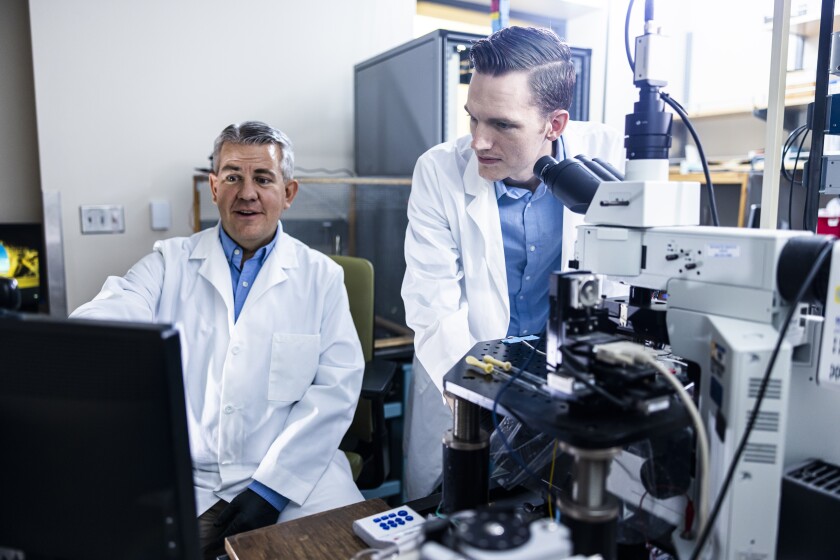Every October, schools around the country celebrate Red Ribbon Week, the nation’s oldest and largest drug abuse prevention campaign. New research from the Edwards Lab in the BYU Neuroscience Center shows the importance of this drug abuse education, revealing mechanisms that explain why young adults are more susceptible to the negative effects of marijuana than adults.
This dopamine research, to be submitted for publication in the Journal of Neuroscience, shows that cells of the brain’s reward center (the ventral tegmental area, VTA) are more resistant to change in adult mice compared to adolescent mice when exposed to tetrahydrocannabinol (THC), the psychoactive component of marijuana. These changes may explain why adolescent brains release dopamine more readily, a process that increases the risk of addiction.

ONE IN SIX
It is well established that THC has more substantial negative effects in teenagers compared to adults. According to the U.S. Centers for Disease Control and Prevention (CDC), approximately one in six teens who regularly use marijuana can become addicted. Additionally, marijuana use in adolescents is associated with lower IQ, deficits in learning and memory, increased anxiety, and a higher risk of developing drug dependence later in adulthood.
“The fact is, when you look at all human studies, the impact of marijuana use is a lot more negative in adolescents than adults,” says Jeffrey Edwards, senior author of the study, professor of cell biology and physiology, and director of BYU’s Neuroscience Center. He conducted the current research to explore why adolescents are more negatively affected.
PUMP THE BRAKES
Dopamine is a chemical in the brain responsible for feelings of reward and pleasure. Normally, GABA neurons put “brakes” on the cells that secrete dopamine to prevent excessive dopamine release. However, when the adolescent brain is regularly exposed to THC, these GABA neurons take their metaphorical foot off the brakes in a process called long-term depression (LTD). The result is an increase of dopamine, a characteristic of addictive drugs, which escalates the risk of addiction.

Previous research published from the Edwards Lab in 2017 discovered a novel form of synaptic plasticity in the brain’s reward center in adolescent mice. Synaptic plasticity is the ability of connections within the brain to change over time. This plasticity is the mechanism that drives normal reward memory and learning, but can also be hijacked by drugs of abuse to create addiction.
“Because marijuana and its psychoactive ingredient THC have such an impact on adolescents, one of the goals of this study was to determine whether there are physiological differences in adolescents versus adults,” Edwards says. “We previously found that in adolescents, there’s more LTD plasticity with chronic THC exposure, so the question was this—in adults, does this phenomenon still happen?”
In the current study, both adolescent and adult mice were chronically exposed to THC over seven to ten days. Isaac Ostlund (’21), the senior PhD student of cell biology and physiology who ran the study as a part of his dissertation research, confirmed that THC can induce LTD plasticity in adult mice too. However, in the adult brain, LTD plasticity required a more intense stimulus.

“Adults resist plasticity, at least with these GABA neurons. All the components required for this plasticity to occur are still there. It’s just harder to get them to change,” Ostlund says. “I think this is the most interesting part of the study because it’s consistent with everyone’s understanding that as we get older, we get more set in our ways, more resistant to learning, more resistant to drugs, and even more resistant to emotion. It’s just generally harder to get things to change.”
THE GATEWAY DRUG
Marijuana is often described as a “gateway drug,” as several studies have demonstrated an association between marijuana use and other substance-use disorders. Until now, the lab’s research has focused on how THC affects the adolescent brain on a cellular level, but now the lab looks to validate these findings in behavior.
“I would really like to look more at some of the behavioral aspects of this,” Edwards says. Future studies would include assessing the behavioral outcomes of marijuana use in adolescent versus adult mice. “Does it change behavior to seek out more THC?” he asks. “People call it a gateway drug, but I don’t know if anyone’s looked in a rodent model at whether they’ll seek out other drugs more readily and why.”
LEGALIZATION
As of June 2021, there are nineteen states with laws legalizing the recreational use of marijuana. An additional eighteen states have laws legalizing marijuana for medicinal use only.
The increasing access (directly to adults and indirectly to adolescents), combined with accumulating research indicating negative effects of marijuana use in teenagers, pose some important questions regarding the regulation of the drug.

“We’ve taken THC and turned it into candy . . . literally,” Edwards says. “And I think in doing this, we’ve done a disservice to the young adult population. By legalizing and allowing easy access to it, we’re telling the younger generation that it’s not a big deal, but the data tells us something else. Adolescent marijuana use is more harmful compared to adults.
“The really big thing for me is that people are a little naïve about the negative impacts of marijuana versus other drugs. We fear cocaine, but we don’t worry about marijuana . . . and that’s a little scary.”